
Why no one reads a text until the end (including this one)
Follow Us @
Why no one reads a text until the end (including this one)
-Trending Marketing news, content marketing, latest Ways to rank your website, marketing discoveries, Local SEO, seo and social media marketing services. enjoy your stay on our website.
This is a free translation of the text “Why You Won't Finish This Article” by SLATE. To check the original version (in English) click here.
I'm going to keep this text brief because you won't be reading for long. I've already lost a lot of you. For every 161 people who entered this page, some 61 – 38 percent – have already left. You “bounced”, in internet jargon, meaning that you did not engage with this page.
So now there are 100 of you. A round number. But not for long! We're at the point on the page where you have to scroll to see more. Of the 100 who didn't bounce, five didn't want to scroll the page. Goodbye!
Okay, cool, it's late. There are 95 of us now.
A friendly number, a more intimate audience, just the people who want to be here. Thanks for reading, guys! I was starting to worry about the limit of your attention span, even your intelligence… wait a minute, where are you going? Are you already tweeting anything about this article? You haven't even read it yet! What if I say something extremely bad, like asking for a constitutional amendment to use two spaces after a period?
Calm down, no, wait, now are you leaving too? Are you going to comment? Oh, come on! There's nothing to say yet. I didn't even get to the nutgraphs.
I better get on with what I was saying. So here's a summary: only a small number of you make it to the end of articles on the internet.
Some truths about reading articles on the internet
I always suspected this, because many smart people go to the comments section to talk about things that I always say towards the end of the article. But now I got the proof. I asked traffic expert Josh Schwartz, an analyst at Chartbeat, to look at how many people scrolled through Slate articles. Schwartz also did something similar for other sites that use Chartbeat and authorized the firm to include their traffic in the integrated analytics.
Schwartz's data shows that readers can't stay focused. The more I write, the more you tune out. And it's not just me. It's not just Slate. It's everyone online. When people access a story, they rarely scroll to the end of the page. Many people don't even make it halfway. An even more discouraging relationship is the relationship between scrolling and sharing. Schwartz's data suggests that many people tweeting links to articles have not read them completely. If you see someone recommending an article online, you shouldn't assume they've read what they're sharing.
Alright, a few hundred words so far. According to the data, for every 100 readers who didn't reach the top, we have about 50 who stayed for now. Only half!
Look at the chart below created by Schwartz, showing where people stopped reading Slate articles. Chartbeat is able to track this information because they analyze reader behavior in real time – every time an internet user is on a Slate page, Chartbeat's software records what the browser is doing second-by-second, including the part of the page that the browser is currently viewing.
A typical internet article is 2000 pixels long.
In the chart below, each bar corresponds to readers who have reached a certain depth in the story. It peaks at zero percent – that is, the top of the page, because 5 percent of readers never scroll below that point. (An important fact: this graph only includes people who spent some time engaging with the page – those users who “bounced” away from the article immediately after landing on it are not represented.
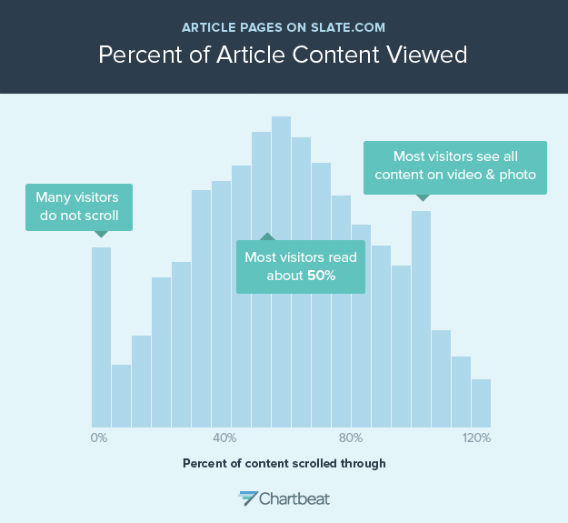
The X-axis goes beyond 100 percent to include things like the comments section, which falls beyond those 2000 pixels. Finally, the spike near the end is an anomaly caused by pages containing photos and videos – on these pages, people go through the entire article.)
Chartbeat data shows that most readers only read up to the 50 percent mark, or the thousandth pixel, in Slate articles. That's not very far.
I looked at the number of recent articles to see how much of a story you would read by stopping at 1000 pixels. Take Mario Vittone's article published this week about the signs that someone could be drowning. If the top of your browser only reaches the thousandth pixel in this article, the bottom of your browser would be at number 1,700 (a typical browser window is 700 pixels tall).
At this point, you would have only read signs 1 and 2 – and you would have missed the fact that people who are drowning don't wave for help, they can't voluntarily control their arms, and another sign that I don't know which one is because I haven't finished reading that article yet.
Take as another example John Dickerson's fantastic article about the IRS scandal or something like that. If you only scroll halfway through that incredible story, you'll only have read the first four paragraphs.
Now, believe me when I say that John wrote some amazing stuff beyond those four paragraphs about who-knows-what he was talking about, some really good points, without trying to give away here, you really have to read it to believe it.
But of course you didn't read it because you received that important email or you needed to watch a video on YouTube and your phone vibrated with a WhatsApp group message…
The worst thing about Schwartz's article is that spike at zero. About five percent of people who have landed on Slate pages and become engaged in some way – and the page is in the background or browser tab and they're doing something else like moving the mouse around randomly – never scroll past that point. Now, what do you know about a typical Slate article if it never happens? No crap.
Depending on the size of the top image and the height of your browser window, you will get, at most, a sentence or two. There's a good chance you won't read anything. And yet, people are leaving without starting. What's wrong with them?
PWhy do they click on the page if they are supposed to do that?
Schwartz's charts find some other sites more encouraging than Slate, but others even sadder.
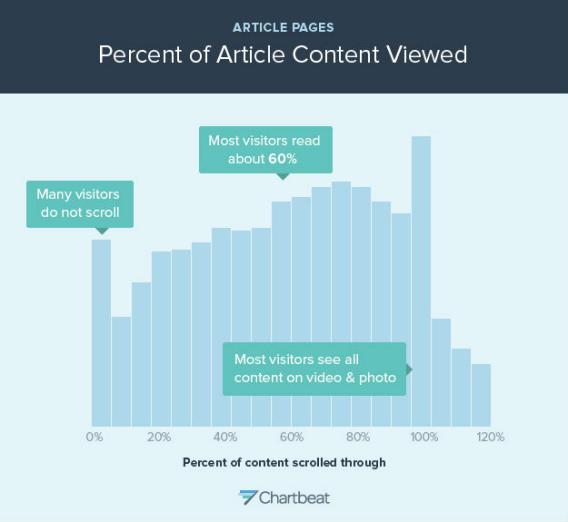
On these sites, the average scroll rate is a little better – most people get to 60 percent of the article, rather than 50 percent here. On the other hand, these pages have a higher number of people – 10 percent – who never scroll down.
In general, this story repeats itself all over the internet: few people are following through, and even more surprising is the large number of people who don't give these articles any chance.
How do people engage with articles on the internet?
We're going deep into the page here, so only my mom must still be reading it. (That hug, Mom!) But let's talk about how scrolling down relates to shares. I asked Schwartz if he could tell me whether people who are sharing article links are more likely to have read what they are reproducing.
He told me that Chartbeat can't directly track when individual readers tweet links, so it can't definitively say that people are sharing the stories before they read the whole thing.
But Chartbeat can look at the number of tweets regarding an article and then compare it to the number of people who scrolled through it. Here's Schwartz's analysis of the relationship between scrolling down an article (and reading it) and sharing a link to a Slate page:
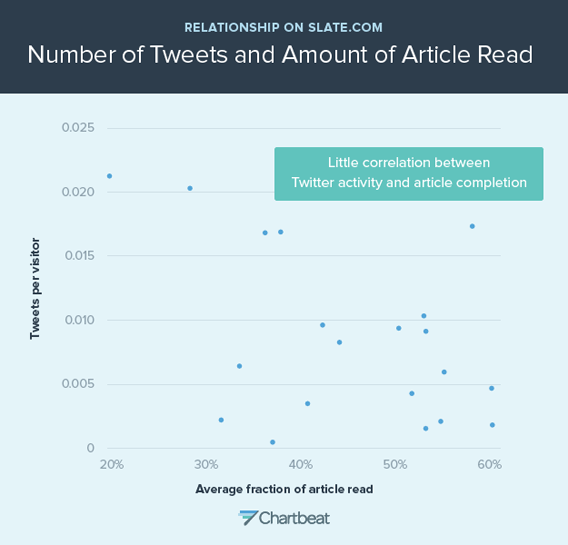
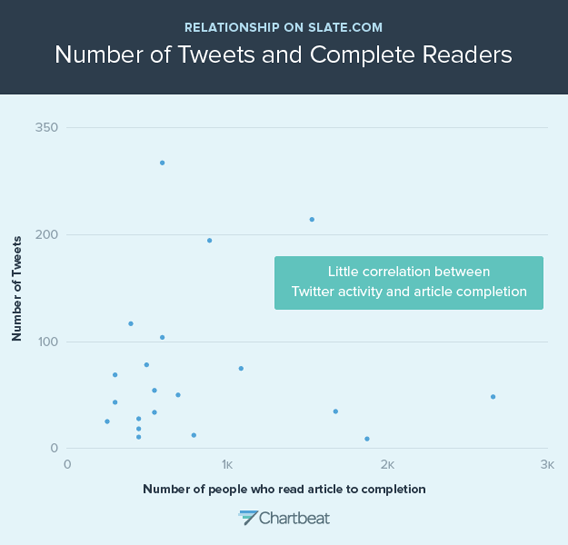
And here's a similar relationship between scrolling and sharing on other sites monitored by Chartbeat:


Each of them shows the same thing. There is little relationship between scrolling down and sharing. Both Slate and other articles on the internet receive a lot of tweets from readers who don't necessarily read everything, or much. Articles that are read to the end do not necessarily receive many tweets.
As a writer, all this data stresses me out.
It may not seem obvious – especially to those of you who have already left here to go see Arrested Development – but I spend a lot of time and energy writing these stories.
I'm even careful about what things I put at the end; for example, right now I'm thinking about what I should say next and whether or not I should include two other interesting graphs that I got from Schwartz, or maybe I should delete them because you lose focus, and now might be the time to conclude things anyway…
But what's the point of all this? Schwartz told me that on a typical Slate page, only 25 percent of readers make it past the page's 1,600 pixel, and we're well beyond that now.
Of course, just like every other writer on the internet, I want my articles to be read by a lot of people, which means I want you to like, tweet, and email this link to everyone you know. But if you haven't done this yet, you probably won't change your mind now.
Nothing at this point matters much.
So, I promise, after these graphics I will finish what I have to say to the people who are still reading this. (A bunch of losers, don't you have anything else to do?)
Here's a heatmap that shows how much time people spend on Slate pages:

And this one shows how much time they spend on other sites analyzed by Chartbeat:
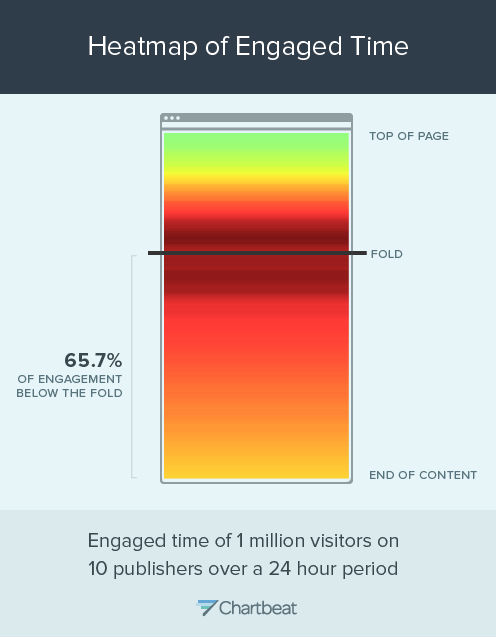
Schwartz told me that I should be happy with my site's heatmap, which shows that people spend a lot of time after the first scroll down in an article window.
In Chartbeat data, almost two-thirds of people spend time below the first part; on Slate that number is 86.2 percent. “That’s really good,” he told me. “We typically see high-quality content make people scroll further than usual, and that’s one of the best results we’ve seen to date.”
Oh yes! Well, there's just one problem: it's probably the fault of our website design that's increasing our numbers there. Since you probably have to scroll down to see anything in the article, our performance in this regard seems incredible. But if our articles started higher up, they might not look so good.
In other words: damn.
Finally, while I hate seeing these numbers when I consider them from a writer's perspective, I'm not really surprised.
I read tons of articles every day. I share dozens of links on Twitter and Facebook. But how many do I read in full? How many do I share after reading the whole thing? Honestly – and I feel comfortable saying this because at this point even my mom stopped reading at this point – not many. I wonder, too, if this applies to more than the internet.
With ebooks and streaming services and television shows, it's easier than ever to switch to something else. In the last year, my wife and I have watched at least half a dozen films only up to about 60 percent. I have several books on my Kindle that I haven't read beyond chapter 2.
Even though I loved it and recommended it to everyone. I never finished the English version of the teen drama Skins. Battlestar Galactica, too – I stopped halfway through hoping to watch it again someday. If I go? Probably not.
Maybe this is just our cultural heritage: we are living in the age of the ephemeral. I want to finish the whole thing, I really do. I hope you wanted too. Seriously, let's stop this! But who do I want to fool? I'm busy, you're busy. There is always something else to see, read, play or eat.
Okat, I said it would come with a neat and well-written ending, but who cares? You certainly don't. Let's just end it like this: See you later, TK.
For more content like this, visit the portal.
Why no one reads a text until the end (including this one)
Follow TODAYSGIST on Google News and receive alerts for the main trending SEO news, Ai news, latest Ways to rank your website, marketing discoveries, Local SEO and lots more!
Why no one reads a text until the end (including this one)
SHARE POST AND EARN REWARDS:
Did you like this post?!!! Join our Audience reward campaign and make money reading articles, shares, likes and comment >> Join reward Program
FIRST TIME REACTIONS:
Why no one reads a text until the end (including this one)
Be the first to leave us a comment, down the comment section. click allow to follow this topic and get firsthand daily updates.
JOIN US ON OUR SOCIAL MEDIA: << FACEBOOK >> | << WHATSAPP >> | << TELEGRAM >> | << TWITTER >
Why no one reads a text until the end (including this one)
#reads #text #including
-
Cryptocurrency2 months ago
NFT Sales Touch IDR 4.3 Trillion in the Second Week of February 2024
-
Sports3 months ago
Making history at the 2023 Asian Cup, the Indonesian national team raises its position in the FIFA rankings
-
Sports2 months ago
PSG Will Try to Sign Frenkie De Jong from Barcelona
-
Sports2 months ago
Falling from Bilbao, Girona's position is threatened in the Spanish League
-
usa today entertainment3 months ago
Adu Outfit Park Min Young Becomes an Office Worker, from Drakor What's Wrong with Secretary Kim to Marry My Husband
-
Sports2 months ago
And Ashworth Urges Manchester United to Seize an Important Figure at Chelsea
-
Trend tech & Telecoms3 months ago
28 Terrorist Group Accounts Get Paid Blue Check on X
-
Sports3 months ago
Lukaku Calls Draw Away Good Results

























